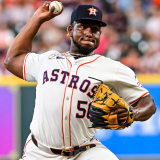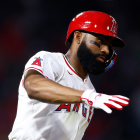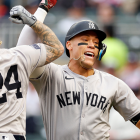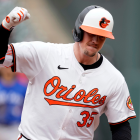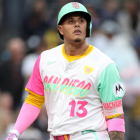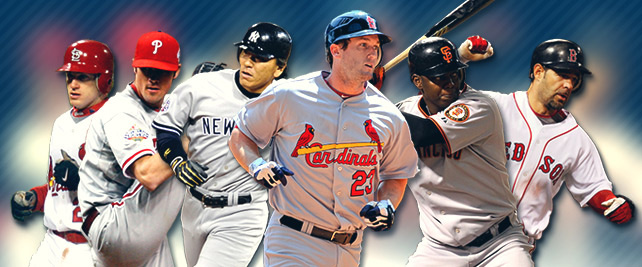
What has been the key to the past decade's worth of World Series champions, and do those champions share any traits with some of this season's 10 playoff teams? Eye on Baseball bloggers Matt Snyder, C. Trent Rosecrans and Dayn Perry take a look.
Angels (Rosecrans)
Although Barry Bonds hit "just" 46 home runs in 2002, he actually had a better OPS in his follow-up year to his record-setting 73-homer season. While Bonds is the poster boy for the so-called steroid era, the 2002 Angels won the World Series with the small ball instead of the long ball. The Angels advanced to the playoffs and ultimately their first World Series title, despite finishing 21st in home runs with 152. But that doesn't mean they didn't score. Mike Scioscia's squad scored 5.25 runs per game, the fourth-best total in the majors that season. Earl Weaver would've hated the team's offense, as they led the American League in sacrifice bunts, they didn't hit homers and only four teams walked fewer than their 462.
But what Weaver would have appreciated was the team's dominant bullpen. Troy Percival anchored the bullpen during the season, aided by Ben Weber and Brendan Donnelly, but it was a 20-year-old rookie who became a postseason sensation. Despite appearing in just five games during the regular season, Francisco Rodriguez became K-Rod as the game's most celebrated set-up man. In 18 2/3 postseason innings, the right-hander with the game's nastiest curveball recorded 28 strikeouts.
Most prominent traits: Strong bullpen, high batting average, low home run total, strong defense.
Possible 2012 teams with similar traits: Giants, Braves
| More playoff coverage |
Marlins (Snyder)
The Marlins headed into the season as an afterthought and were still one when they fired manager Jeff Torborg. At one point, the Marlins were 10 games under .500, but they got hot enough down the stretch to win the NL wild card. They entered the postseason a heavy underdog against the defending NL champion Giants. Then they entered the NLCS overshadowed by the "cursed" Chicago Cubs. Next, the Marlins went to the World Series a heavy underdog against the vaunted Yankee Dynasty.
Behind underheralded (at the time) corner infielders Derrek Lee and Mike Lowell, star veteran backstop Ivan Rodriguez, young leadoff man Juan Pierre, rookie sensation Miguel Cabrera and highly-touted -- albeit not fully developed as an ace -- young starting pitcher Josh Beckett, the Marlins shocked the world.
They weren't great on paper but exceeded expectations at every turn. Timeliness always matters with teams like this. For example, the only time in the playoffs the Marlins' backs were against the wall was in Game 6 of the NLCS against the Cubs. Trailing 3-0 with just five outs to go, the Marlins mounted an 8-run inning. The key play was a booted ground ball by Cubs shortstop Alex Gonzalez, but Lee doubled to tie the score immediately thereafter and the Marlins didn't relent until the game was out of hand.
Most prominent traits: Inexperienced up-and-comers with a "no one believed in us" chip on their shoulder. Also had a few "magical" moments that made you feel like it was a team of destiny. Oh, and a strong, veteran manager.
Possible 2012 teams with similar traits: Orioles, Athletics, Nationals
Red Sox (Snyder)
We all know the story. The Red Sox broke an alleged curse in winning their first World Series since 1918. Not only that, they had to overcome a 3-games-0 deficit to their longtime nemesis (the Yankees, obviously) in the ALCS. And they did it.
The Red Sox weren't some little engine that could, however. They were 98-64 in the regular season, boasted an extremely potent offense (first in the AL in OPS, plenty of power), had a strong front end of the rotation and a good closer.
The Red Sox crushed the Angels in the ALDS, hitting .302/.403/.457 as a team in the three-game sweep. The ALCS brought the lore of the Dave Roberts steal, clutch Big Papi, Curt Schilling's bloody sock and Johnny Damon going upper tank in Yankee Stadium. And much more. The World Series, of course, was a sweep that felt like a mere formality.
Most prominent traits: Power hitting, power pitching, good closer, togetherness and not worrying about another postseason failure -- which is putting things like a "curse" out of their collective minds.
Possible 2012 teams with similar traits: None is a perfect match. The Rangers are close, having lost two straight World Series -- the franchise has never won one -- and packing the power on offense, though the starting pitcher falls a bit short. The Yankees fit the profile of top-end of the rotation, lock-down back-end and a power-hitting offense. They most obviously don't have -- nor do they want or need -- the whole breaking-a-curse thing. Reds are similar to Yankees here. Nationals are not far off, either. Maybe Orioles and A's, too, in different ways?
2005 White Sox (Perry)
Throw in their postseason record, and the '05 White Sox went 110-64. Not bad.
In the regular season, they ranked ninth in the 14-team AL in runs despite playing in a hitter's park, so the offense was far from impressive. The pitching staff, however, paced the AL in ERA. The rotation's front four of Mark Buehrle, Freddy Garcia, Jon Garland and Jose Contreras was simply outstanding, and the bullpen was tops in baseball.
Also key to the Sox's exceptional run-prevention numbers was an outstanding team defense. In fact, the White Sox that year ranked second in all of MLB in defensive efficiency, which is simply the percentage of balls in play that a defense converts into outs. It was just tough to score any runs on Chicago in 2005. Throw in an offense that, while not good overall, managed to hit 200 homers, and you've got a recipe for success. And succeed they did. After all, an 11-1 playoff run doesn't happen every year.
Most prominent traits: Good starting pitching, great relief pitching, a standout defense and power.
Sound like anyone in 2012?
Possible 2012 team with similar traits: A's
2006 Cardinals (Perry)
Famously in some parts infamously in others, the '06 Cardinals barged to the belt and the title despite winning just 83 games in the regular season. In that regular season, they were, well, generally average. They were a bit better than average in terms of runs scored, but they were a bit worse than average in team ERA. Only one starter, Chris Carpenter, managed an ERA below 4.00, and only rookie Adam Wainwright spared the bullpen from being one of baseball's worst. On the plus side, having the eventual NL MVP (Albert Pujols) in the lineup certainly helps.
Were they better than they seemed? At one point, the Cards were 31-16, but injuries to David Eckstein and Jim Edmonds hurt, as did losing Mark Mulder for the season (although he was struggling at the time of his injury). Pujols also hit the DL for the first time in his career. With the exception of Mulder, those guys were healthy for the postseason.
And then guys like Yadier Molina, David Eckstein, Jeff Weaver and Jeff Suppan turned into different players once the calendar flipped to October. The '06 Cardinals are nothing if not proof that every team that makes the playoffs has a chance.
Most prominent trait: Getting healthy/hitting stride at the right time.
Possible 2012 team with similar traits: Tigers
2007 Red Sox (Snyder)
Though just a few years removed from the "Idiots," these Red Sox were a bit different. They had new blood in several prominent spots and didn't have to worry about the weight of an alleged curse.
The makeup was also a bit different, as the Red Sox led the AL in doubles and finished second in on-base percentage, but finished eighth in homers. The pitching staff was great, leading the AL in ERA and finishing third in strikeouts.
These Red Sox made it through the regular season as the best team in baseball and entered the playoffs as one of the favorites to win it all. They were challenged in the ALCS, but not the ALDS or World Series, both of which were sweeps.
Ace Josh Beckett and closer Jonathan Papelbon were stellar in the postseason while the offense had a collective .395 on-base percentage with 17 doubles in the seven-game ALCS win over the Indians.
Most prominent traits: Strong gap power, good defense, shutdown playoff ace and top-to-bottom good pitching staff.
Possible 2012 teams with similar traits: The Braves are close on a few fronts, as are the Rangers, Nationals and Reds. Aside from good defense, the Tigers are a strong match.
Phillies (Rosecrans)
While the more recent Phillies teams have been built around pitching, the 2008 squad flat mashed. The Phillies led the National League in home runs, hitting 214 during the season, led by Ryan Howard's 48 home runs. The team's top five hitters in the lineup -- Jimmy Rollins, Shane Victorino, Chase Utley, Howard and Pat Burrell -- combined to hit 139 homers, more than the Dodgers, Braves, Blue Jays, A's, Mariners, Royals, Nationals, Twins or Giants.
In the playoffs, Cole Hamels was the very definition of an ace, going 4-0 in five starts with a 1.80 ERA. Meanwhile, closer Brad Lidge didn't blow a save in either the regular season or the playoffs. The Phillies cruised through the playoffs, losing just one game in each of their three series, including the rain-soaked World Series against the Rays.
Most prominent traits: Power hitting, dominant closer, top of the rotation ace.
Possible 2012 teams with similar traits: Orioles, Yankees
2009 Yankees (Snyder)
The Yankees brought baseball's best record into the postseason and entered the playoffs as an overwhelming favorite to win the title. The offense led the league in runs, home runs, on-base percentage and slugging percentage. The starting pitching staff was top heavy with a big three of CC Sabathia, A.J. Burnett and Andy Pettitte, and obviously the best closer in baseball history was anchoring things in the bullpen.
In the playoffs, the Yankees stuck with the formula. They used a shortened playoff rotation, using only the aforementioned "big three," several times on short rest. They hit for power, racking up 24 doubles, two triples and 20 homers in their 15 playoff games. Mariano Rivera was his usual, dominant self, too, as he saved five games in five chances while allowing only one earned run in 16 innings (0.56 ERA).
Most prominent traits: Strong front-end of rotation, power hitting, strong back-end of bullpen
Possible 2012 teams with similar traits: Reds, Yankees and possibly Nationals and Cardinals.
2010 Giants (Rosecrans)
So much of baseball in the last 20 years or so has focused on offense, but the 2010 Giants showed you can win by not allowing runs, just as you can win by scoring in bunches. The Giants offense was more or less average -- its OPS of .729 was just one thousandth off the MLB average and its 4.30 runs scored during the season were fewer than the 4.38 scored per team in baseball in 2010. But where the team shined was pitching -- and not just starting pitching, but also a strong bullpen. Tim Lincecum was coming off back-to-back Cy Young awards, but was replaced by Matt Cain as the team's de facto ace. Cain, Lincecum and Madison Bumgarner provided the heart of the rotation, with Jonathan Sanchez delivering what in retrospect was a career year. The bullpen with Brian Wilson, Sergio Romo, Santiago Casilla and Jeremy Affeldt put up a 2.99 ERA.
San Francisco trailed San Diego in the NL West for much of the season before catching the Padres thanks to an 19-10 record in September and October, thanks to a shrewd pickup of Pat Burrell off the scrap heap from Tampa Bay and the addition of Cody Ross. Those two helped jolt the team to the postseason and continued to produce in the postseason. What the Giants could count on, but most teams get somewhere along the way, are the surprise performances. Shortstop Edgar Renteria was limited to just 72 games in the regular season before seizing the World Series MVP with a .412/.444/.765 line against the Rangers, while center fielder Andres Torres also performed above his a regular-season numbers. That offensive production coupled with the stellar pitching earned the Giants the first World Series title in San Francisco history.
Most prominent traits: Strong starting pitching, shutdown bullpen, unexpected offensive boost
Possible 2012 teams with similar traits: Reds, Giants, Athletics
2011 Cardinals (Perry)
The miracles of 2011 are still fresh in our minds. The only thing more miraculous than the final day of the regular season was Game 6 of the World Series. Running a distant third might be the overriding fact that the Cardinals prevailed despite being heavy underdogs in each of their three postseason series.
In the end, this was a team carried by the offense. St. Louis paced the NL in runs scored, batting average, OBP, slugging percentage -- just about any meaningful offensive measure. Even if it wasn't the best team (and it wasn't), a team that so dominates such a vital component of the game is always capable of surprise. And so they did surprise us.
Elsewhere, a gradual revamping of the bullpen paid big dividends by the time the postseason rolled around, and the addition of Rafael Furcal helped stabilize what had been a spotty infield defense. Although the rotation lacked a shutdown ace, there was depth in the one-through-four spots after the trade for Edwin Jackson.
The Cardinals made their October run thanks to a powerhouse offense, a capable rotation, and a young bullpen peaking at the right time.
Most prominent traits: Power and on-base skills in the lineup; health at the right time; key deadline additions; fresh, hard-throwing bullpen.
Possible 2012 teams with similar traits: Um, the Cardinals? Yankees, too.
For more baseball news, rumors and analysis, follow @EyeOnBaseball on Twitter, subscribe to the RSS feed and "like" us on Facebook.








